

sustainers for stringed musical instruments
SUSTAINIACÒ
MODEL C ELECTRO-ACOUSTIC SUSTAINERA sustainer is the only effect that operates directly on the strings of the instrument. All other effects change the signal that you hear.
|
September 1, 2014 Due to discontinuation of certain critical parts we have to suspend production until suitable replacements become available. |
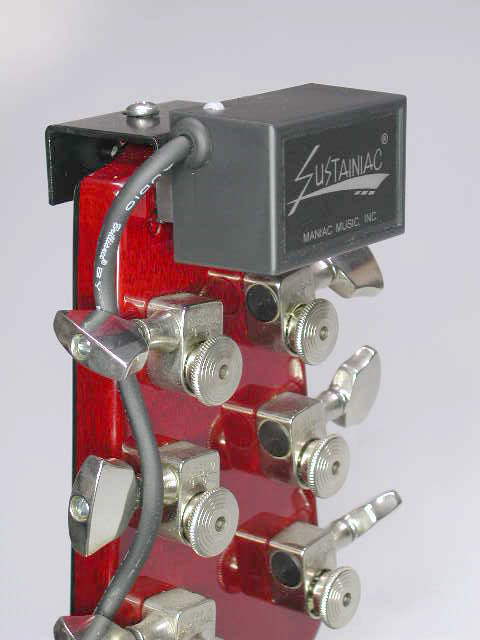
|
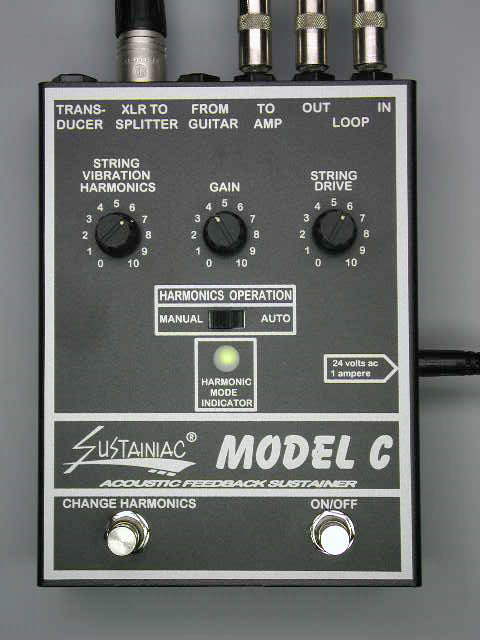 |
You can get a longer transducer cord (18 ft.) by adding $10 to the $279 standard price. A longer 15 ft. cord routing system adds $15 to the $359 price.
The Model C has been designed to not only replace the Model B, but to improve on things that we thought needed improving. We introduced the Model B in 1987. Most of them are still out there, being used on a daily basis. One thing we redesigned is the headstock-mounted transducer. With the Model B, you had to glue a 4.5 ounce magnet to the headstock, then attach a 6-ounce trandsucer to this. The new Model C has a 6.5 ounce transducer (total weight, transducer plus magnet plus clamp) that clamps on quickly. No mounting with glue or screws. Furthermore, the transducer cord is substantially thinner and lighter than with the Model B.
TOPIC LIST
Overview of the SUSTAINIAC MODEL C sustainer
Basic differences between the Model C and the Model B sustainers
Optional cord-routing system
No Installation Required
Performing with the MODEL C
Comparison of Model C with Stealth PRO and other electromagnetic sustainers
How intense is it?
Features and Controls
Pedals: Dual Mode Harmonic Select control
Knob Functions
Transducer mounting details
Optional transducer mounting details
Guitars with piezo and other bridge types
Wireless Model C?
Operation with European/Japanese power line voltage
Pricing
Ordering information
Warranty
Specifications:
How the SUSTAINIAC MODEL C sustainer works
MODEL C Owner's manual (PDF file)
Overview of the SUSTAINIAC MODEL C sustainer
The Sustainiac Model C sustainer is an electroacoustic type sustainer. It makes your string vibrations
sustain by making feedback. It is like getting natural amp feedback from a very large, loud amp. Only it is much, much more
intense and predictable. Amp feedback often fails to work because of room acoustics from place-to-place. With the
Sustainiac Model C sustainer, you get successful intense feedback sustain at any volume level.
Go to the ABOUT SUSTAIN page for a more thorough explanation
of this phenomenon. The Model C consists of two separate parts: The string-driver transducer
and the floorbox SustainiampÔ
controller/amplifier. The Sustainiamp takes your guitar signal, amplifies it, and then sends this
amplified signal to the transducer. There is a "TO AMP" jack on the Sustainiamp that splits off the raw guitar signal and sends it
directly to your regular guitar amp or effects chain. This signal is hard-wired, so you hear only your raw, unprocessed guitar
signal.
The transducer is a cube-shaped box about the size of an egg. See above photo.
It mounts onto the instrument body, preferably the headstock. The transducer produces sound vibrations in that part of the
instrument body. You can feel the instrument vibrate as you play. Some of this vibration energy coming from the transducer
gets transferred to the strings, where they sustain their vibration for as long as you want them to.
INSTANT SUSTAIN: One main advantage of the Sustainiac Model C acoustic-type sustainer is that no special installation is needed. As soon as you take it out of the box, the transducer can be clamped to the guitar headstock, and you are sustaining in a few minutes.
Basic differences between the Model C and the Model B sustainers
TRANSDUCER DIFFERENCE: One thing we redesigned is the headstock-mounted transducer. With the Model B, you had to
glue or screw a 4.5 ounce magnet to the headstock, then attach a 6-ounce trandsucer to this. The new Model C has a 6.5 ounce
transducer that simply clamps on (total weight, transducer plus magnet plus clamp). No glue or screws. It is easy to quickly
transfer the Model C to different guitars.
With the Model B, the transducer cord hung down from the guitar headstock and went down to the Model B floorbox control unit.
Also, your guitar cord had to go down to the box, to provide an input signal for the sustainer. Two cords to deal with.
With the Model C, we have a thinner transducer cord.
OPTIONAL CORD ROUTING SYSTEM (see picture below) Some people objected to having a cord hanging down from the guitar headstock. We have developed a new (optional) cord-routing system. A thin cord goes over to the guitar strap, and attaches to the strap with stick-on clips. A small junction box fastens to the strap near the bottom strap button. The transducer cord plugs into the junction box. An 18-inch guitar cord comes out of the box, and plugs into your guitar. A single 10-ft (or optional 15-ft) cable runs from the junction box down to the Sustainiac control box on the floor. This single cable carries the guitar signal down to the floor, and also the Model C transducer drive signal up. So, you end up with only a single cable that you have to drag around.
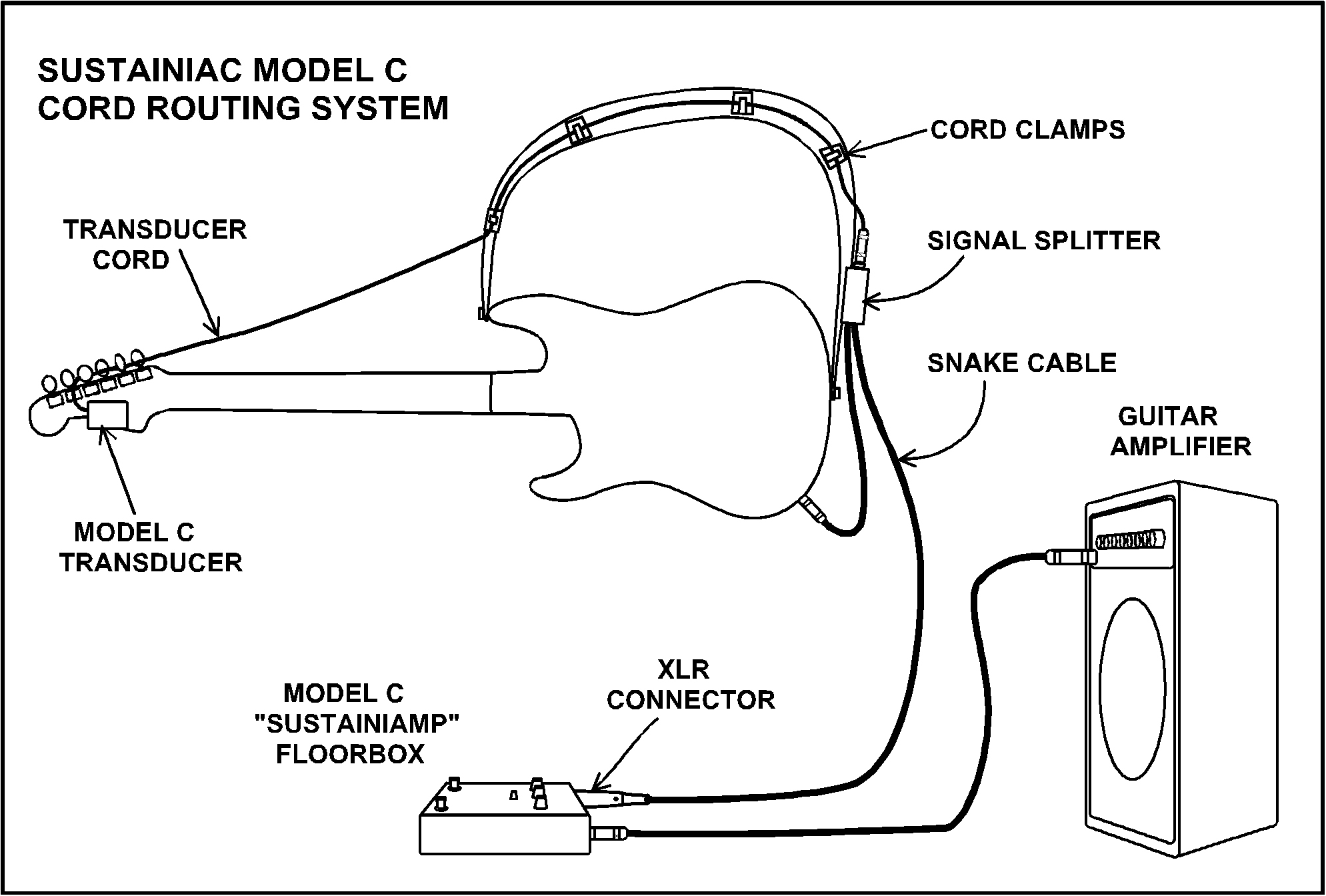
CONTROL DIFFERENCE: The Sustainiac Model C offers a new way of changing the harmonic mode of operation. We have invented a new Automatic mode, where the player can force the harmonic mode to change without having to step on the switch. You simply touch the vibrating string lightly for an instant, and the mode will change. Or, you can simply reduce fretting pressure for an instant. A special circuit inside the Model C responds to a decaying note. (We invented it to prevent the occasional dead fret that you get when the vibration energy from the transducer reaches the string out of phase with the string vibration.) It works for this, but we found it cool to be able to touch the string and get the harmonic change. You can still step on the switch and cause the harmonic change with your foot.
NEW EFFECTS LOOP: We have included an effects loop on the Sustainiac control box that only functions on the transducer signal. You can add an equalizer or other effect (such as volume control, wah-wah, or time delay) to tweak the operation of the Model C. Using a wah-wah or small time delay (1-10 milliseconds) you can actually change single sustained note harmonics several times. But you don't hear the "wah-wah" or time delay function, because it is not in the signal loop that you hear. It is only in the Sustainiac signal path.
No Installation Required
This is the main difference between an electroacoustic sustainer and an electromagnetic sustainer.
For more differences, go to the page which describes MAGNETIC VS.
ACOUSTIC SUSTAINERS. The Model C doesn't have to be installed inside of the instrument, like a magnetic type
of sustainer does. All of your instrument pickups work with the Model C. Again, this is unlike a magnetic type of sustainer
where only the bridge pickup typically works when the sustainer is on. The only requirement is that your guitar has a headstock.
(Sorry, Steinberger owners). You can use several guitars at a recording session and use the Model C with all of them.
Performing with the MODEL C
Most sustained notes will morph into cool-sounding harmonics within a short time after the note is played.
The morph time depends on how high you turn up the GAIN and/or DRIVE control.
Some notes will remain as fundamental vibration. Then, you can force the note to fade into a harmonic by stepping on the
HARMONIC CHANGE footpedal.
Some chords will sustain two or three notes, but most morph into a single note after several seconds.
Following are some playing tips for sustainer users:
(1) LET THE SUSTAINER TAKE OVER THE PLAYING DYNAMICS: Heavy-handed pickers get immediately frustrated and confused by sustainers. When you dig in real hard with a heavy pick, a lot of vibration energy is put into the string. The string vibration amplitude will have to die out some to reach the level where the sustainer energy takes over. This makes for an unpleasant playing experience.
The idea is to play with a light picking touch when you are using the sustainer. Use hammer-ons and tapping where convenient. Then, the sustainer makes the notes swell. String vibration amplitude doesn't "die down" to the sustainer energy level. This adds a new twist to playing, and is the key to making a sustainer an essential part of your "bag 'o tricks".
(2) GETTING USED TO FEEDBACK: If you are used to playing at a loud volume, you get feedback from your amplifier. You have probably developed your technique so that you automatically hand mute the strings that aren't being played. This keeps them under control, so that they don't feed back when you don't want them to. It is natural for you. Playing in front of a large, loud amplifier can make handling the guitar like trying to ride a bucking bronco! Particularly if you play a hollow or semi-hollow body guitar. On the other hand, if you are an "unplugged" acoustic player, or only practice quietly at home, you probably don't hand mute. At first, playing with SUSTAINIAC may seem frustrating, because the strings try to jump to life when you don't want them to. After a little getting used to, hand muting becomes second nature.
Comparison of Model C with Stealth PRO and other electromagnetic sustainers
People often ask about how the feedback sustain of an electroacoustic-type sustainer like the Model C
compares to that of an electromagnetic sustainer like the Stealth PRO. They ask questions like "Does the Model C
tend to make 2nd or 3rd harmonics?". It turns out that it is not that simple.
With an electroacoustic sustainer like the Model C, you can't really make a statement about what harmonic mode is going to dominate after the initial vibration period is over like you can with an electromagnetic sustainer like the Stealth PRO. What harmonic mode ends up for a particular note is determined strictly by the physics of how the transducer energy reaches the string.
Here is what happens: The pickup senses the string vibration, and sends this signal to the "Sustainiamp" amplifier. The Sustainiamp amplifies the pickup signal, and the sends this to the transducer. Sound travels from the transducer to the fret. The distance from the transducer to a fret varies from about 6 inches to about 2 feet, depending on what fret is being used for that note. This takes about 0.1 to maybe 2 milliseconds, depending on what fret is being used. During this time period, the phase of the note will change from about 10 degrees to a full 360 degrees, depending on the note frequency and also upon the d istance between transducer and fret. Furthermore, additional phase shift occurs due to the way pickups work.
If the transducer energy that reaches the fret happens to be in phase with the string vibration, the sustained note vibration will be a fundamental. But most likely, the energy will be out of phase with the fundamental mode string vibration. How much out of phase depends on all the variables just explained. The energy will usually reach the string more or less in phase with SOME harmonic mode (but not necessarily). That is the mode that will end up being the final vibration mode of the string at the particular fret being used. The harmonic mode that is the most in phase with the energy reaching the string has the most gain, and therefore will "win out". But you cannot say you will get "second harmonics" or "third harmonics" as some people want to generalize, as you can understand from the above explanation. In some cases, the energy will reach the fret almost precisely 180 degrees out of phase with the string vibration, which quickly stops the note. If you are in AUTOMATIC mode, the sustainer will automatically change phase in this case, which then causes the vibration to be in phase with the note.
With chords, one note will typically win out because it has the most gain. But doubles and triples will often ring for some time before one note finally wins.
You can have further control over sustained note harmonics by using the built-in effects loop. The effects loop only affects the signal going to the Sustainiac transducer, not your guitar signal that you hear through your amplifier. You can put a wah-wah in the effects loop and control phase shift with your foot. If you can find a time delay that adjusts between zero and 5-6 milliseconds, you can use this to the same end. You can also put a graphic EQ in the loop and fine-tune the Model C to a particular guitar.
How intense is it?
The sensation of playing with the Sustainiac Model C sustainer is indeed intense
and exciting. Musicians often say that it feels like the instrument is actually alive in their hands. Yes, you definitely feel the
vibrations! This sensation is like playing at extreme, deafening volume levels. Yet, the instrument amplifier volume can be turned
all the way down to zero. The intensity and responsiveness are fully adjustable. Play screaming solos all night in your
home, without the police showing up! Curious people often ask us if this vibration will harm their guitar. We have had
the Model B on our demo guitars for over 15 years now (some of them valuable vintage instruments). We have never had
any damage, not even a tuner screw backing out.
Features and Controls

GUITAR IN: The GUITAR IN jack connects directly to your instrument.
TO AMP: The TO AMP jack connects to your instrument amplifier or effects chain. The TO AMP jack is hard-wired to the GUITAR IN jack. Therefore, only your raw, unprocessed guitar signal goes to your amp/effects.
TRANSDUCER: The TRANSDUCER jack connects to the transducer on the headstock.
XLR TO SPLITTER: The XLR TO SPLITTER jack is for the optional cord-routing system. A single snake cable carries the guitar signal down the snake to the Sustainiamp, and also carries the transducer drive signal up the snake to the transducer. When using the cord-routing option, you don't have to use the GUITAR IN or the TO AMP jacks.
LOOP - OUT/IN: The effects loop is for the Sustainiac processing signal only. You do not hear any effects connected here in your guitar signal. You can put a graphic equalizer in here to tailor the Sustainiac response to a particular guitar for an important recording session. Or, you can put a WAH-WAH pedal and actually squeeze several harmonics out of a single note. Or, a short adjustable time delay (1-10 milliseconds) will accomplish the same thing. A compressor pedal will actually enhance sustain. In short, using this effects loop, you can do things with an electric guitar that no one has ever thought of before.
Pedals: Dual Mode Harmonic Select control
The Sustainiamp controller/amplifier has two footpedals. The footpedals control the sustainer ON/OFF function
and also the harmonics of sustained string vibration. Itís simple to use:
The Model C has two modes of operation: MANUAL and AUTOMATIC. A slide switch on the control panel allows you to run in either mode. In either mode, you can force the harmonic mode to change from RED to GREEN and vice-versa by stepping on the CHANGE HARMONIC footswitch. A dual-color LED lights up either GREEN or RED, to let the user know which harmonic is being played. But in AUTO mode, you can force harmonic changes in another way: Simply lightly touch a vibrating string, or quickly reduce fretting pressure for an instant, and you can force the note to change harmonic vibration mode. Also, in AUTO mode, if a note happens to be out of phase with the sustainer vibration that travels up the neck to the fret, AUTO mode will take the quickly decaying note and change modes, turning the note into a robustly vibrating note.
Knob Functions:
STRING VIBRATION HARMONICS: Changes the frequency equalization of the Sustainiac signal path. Rotating this control full clockwise allows all highs to pass, but attenuates the lows. You get mostly harmonics in sustained vibration. Middle rotation allows both highs and lows to pass. You get both harmonics and fundamentals in sustained vibration. Rotating full counterclockwise allows all lows to pass, but attenuates the highs. You get more fundamentals in this position.
GAIN: Determines how fast sustained string vibration builds up. Full gain produces instantaneous sustain. Lower gains take longer to build up sustained vibration and harmonic changes.
STRING DRIVE: This control controls final power amplifier gain. Like the GAIN control, it also determines how fast sustained vibration builds up. DRIVE also controls how strong the final sustained string vibration will be. It also overlaps the above-mentioned GAIN control, but GAIN doesn't affect final string vibration amplitude.
DIFFERENCE BETWEEN DRIVE AND GAIN: People often ask what the difference is between these two functions. First, they are both similar in that they both change the overall system gain. This determines how fast the sustained vibrations build up. The important difference is this: The DRIVE function also controls how much energy is actually delivered to the strings. As you hold a sustained note and adjust the DRIVE knob up and down, you can see the string vibration amplitude change. If you have an ac line power meter or current meter, you will also see this change in response to DRIVE knob settings. With changes in GAIN setting, you will not see the amplitude change. One way to think of it is to compare these two settings to the PRE-GAIN and POST-GAIN settings of a typical distortion box. The PRE-GAIN setting controls the amount of distortion that the signal has. The POST-GAIN setting controls the volume of the signal. But both settings control the overall amount of system gain.
Transducer mounting details
Why mount the transducer to the headstock? Because the headstock is by far the best place on a
typical electric guitar to mount the transducer. Since the mass of the neck is small compared to the body, it vibrates
very easily. The acoustic vibrations efficiently travel into the strings through the frets.
There is another good reason for mounting the transducer on the headstock: The headstock is the furthest location on the instrument from the pickups. The transducer is basically an electromagnetic device, like a loudspeaker. Putting it on the headstock keeps the intense magnetic field that is radiated by the transducer from being sensed by the pickups. This prevents strange sounds and uncontrollable squeals from being sensed by the instrument pickups. You can turn the gain way up, resulting in robust sustain. Put the transducer too close to the pickups, and an uncontrolled oscillation (squeal) occurs as you turn the gain up, before you get enough gain to make the system sustain properly.
The new clamp is easily mounted to a typical headstock by adjusting the thumbscrew for firm pressure. A silicone rubber pad holds the transducer firmly to the headstock with only moderate clamping pressure, and is chemically inert to protect the guitar finish.
The transducer plugs into one of the six jacks on the Sustainiamp floorbox. Your guitar cable plugs into a second jack on the floorbox, and your amplifier into a third jack. For playing onstage, the transducer cable (13ft. standard length) can be attached to the guitar cable to keep it out of the way. The 13-ft. length is optimal when using with a standard 10 ft. guitar cord. Optionally, you can order the transducer with a 18 ft. cord at extra cost, which mates with a standard 15 ft. guitar cord. Or, use the optional cord-routing system described above.
Sustain of notes with an acoustic sustainer tends to be much like that of natural feedback that you get from a loud amplifier: Most notes change into cool-sounding harmonics within a short time after the note is played. Some notes will remain as fundamental vibration. Then, you can force the note to go into a harmonic by stepping on the appropriate footpedal. The best part is that you donít have to play at a loud volume to get screaming feedback sustain! The sensation of playing with the Sustainiac Model C sustainer is very intense and exciting. Musicians often say that it feels like the instrument is actually alive in their hands. This sensation is like playing very, very loudly, yet the instrument amplifier volume can be turned all the way down to zero.
Optional transducer mounting details
Over the years, we (and others) have experimented with optional ways to mount the Model C transducer. You can actually
mount the transducer to the body using the strap button. You have to remove the thumbscrew and the nylon acorn nut that is
attached to it. You also have to remove the moveable clamp piece by removing its
retatining screw. The screw is held in place by a thread-lock glue, so it is kind of hard to break the glue bond. Doing this
places the transducer much closer to the pickups (particularly the bridge pickup). Uncontrolled squeal (oscillation) occurs
until you reduce the GAIN and/or DRIVE control settings. On guitars having small bodies, this distance is reduced and
less gain can be used. Still, if you hate having the wire hanging from the headstock, this might be worth trying. The transducer
must be centered on the pickups. You will notice that if you rotate the transducer, there will be a "sweet spot" where magnetic
radiation to the pickups is minimum and consequently the squealing is minimized. It does work, though not as good as
when you mount the transducer to the headstock. Another reason for this is that the body has more mass to vibrate than the headstock.
Guitars with piezo and other bridge types
We have also had some success on acoustic guitars having piezo and other bridge types. With piezos, you should have
a built-in preamp to boost the piezo signal, and also to lower its output impedance. One particularly good transducer for this
is the Schertler Bluestick undersaddle transducer. The Bluestick is designed to be an acoustic guitar pickup.
This is actually a small condenser microphone that is
contained inside a small under-saddle tube. Schertlerusa.com
With the Bluestick, you can actually mount the transducer directly on the bridge, because it doesn't respond at all to the
magnetic field that radiates from the Model C transducer. What is interesting is that you get
good fundamentals with this, because there is no time delay between the transducer output and the string ends. We have
not done any long break-in experiments with the Bluestick, to determine whether or not this will damage the transducer. If
you are brave and have cash to experiment, this might make a lot of acoustic players happy.
Wireless Model C?
People often ask if they can use a sustainer like the Model C and play wireless, without the cord hanging
down. The problem with wireless is you have to have a lot of power to run an electroacoustic type sustainer like the Model C.
You would have to put BIG batteries inside the guitar body. You would also have to put the Model C Sustainiamp electronics
somewhere inside the body, because it must drive the transducer. You can see from this explanation that it would be very
impractical to do this. But theoretically it is possible.
Operation with European/Japanese power line voltage
The Model C is powered by a 24 volt, 1 amp wall-transformer ("wall wart"). The supply produces 24 volts AC (not DC). The transformer plugs in to the side of the "Sustainiamp" floor-box. At the present time, this transformer is only available for U.S. line voltage of 120 volts. For European 220/240 volts and Japan 100 volts, we recommend that you get the appropriate conversion transformer for your local line voltage to the U.S. 120 volts. If you can find a 24 volt ac, 1 amp transformer, then we can deduct $7.50 from the cost of the Model C. But, remember, the supply must produce 24 volts AC (not DC).
Pricing
The SUSTAINIAC MODEL C sustainer basic price is $279 with a 13 foot transducer cord. This 13-foot cord mates well with a standard 10-foot guitar cord. The cord has a standard stereo phone plug that inserts into the 1/4 inch "TRANSDUCER" phone jack in the Sustainiamp floor box. For an extra $10, we can substitute an 18 foot transducer cord. This mates well with a standard 15 ft. guitar cord.
The optional CORD ROUTING SYSTEM is $80. It has a 10 foot multi-conductor cord which carries the guitar signal down to the floor, and also the transducer signal from the floor box up to the transducer. A small junction box attaches to the guitar strap and joins all the signals to the multiconductor cord. For 15 ft. cord-router cable, add $15 ($90 total).
Shipping weight approx. 7 lbs.
Warranty: One year from date of purchase.
Specifications: Power consumption: 30 watts, 120 volts, 50/60 Hz. Wall type transformer is 24 volts secondary, 1 ampere minimum. Input impedance: 1Meg ohm; Output impedance: 5 ohms. Shipping weight: 7lbs. Amplifier dimensions: 3.6"Hx6.1"Wx9.1"L.
How the Sustainiac Model C sustainer works
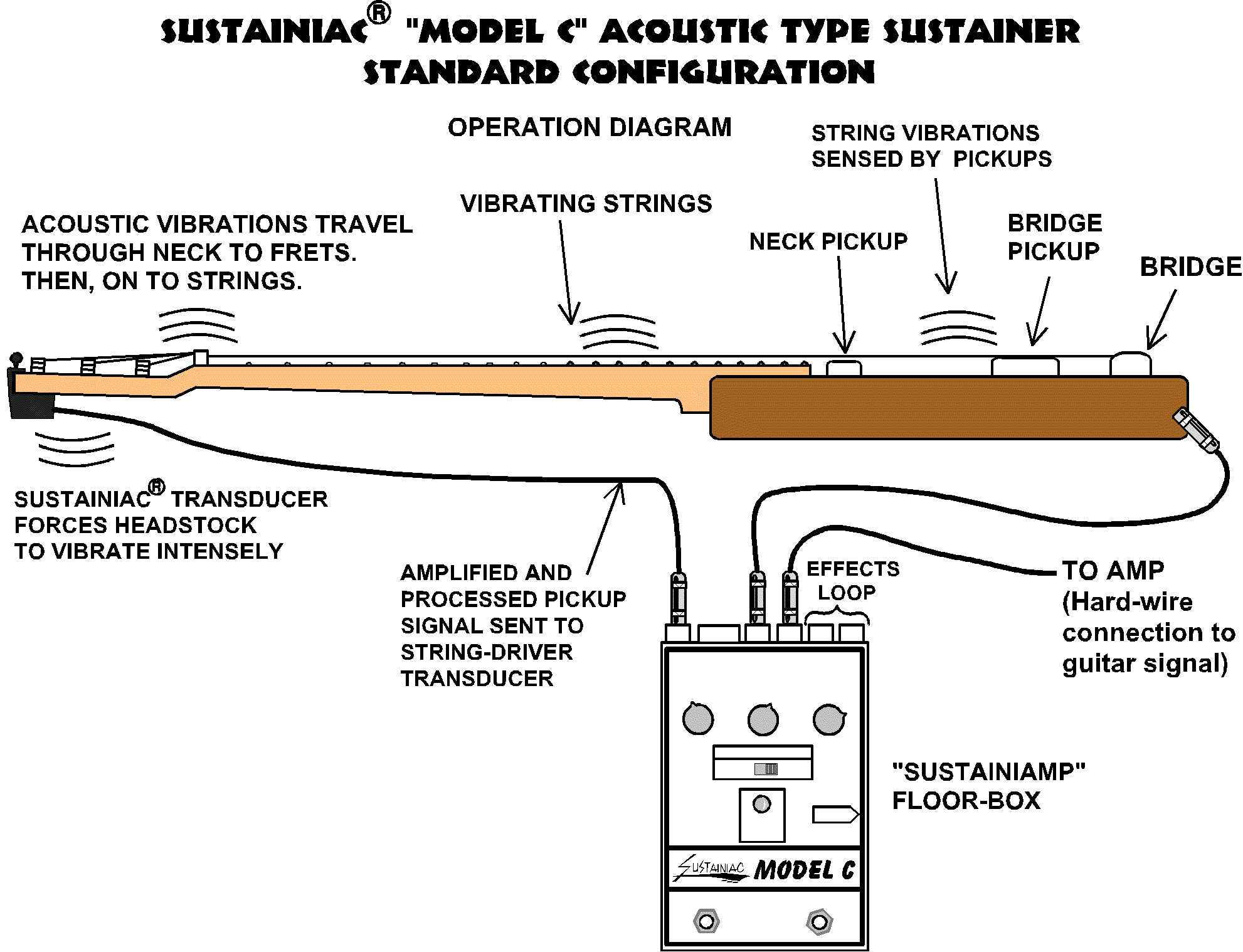
The STANDARD hookup diagram is shown above. The hookup diagram with OPTIONAL CORD-ROUTING SYSTEM is shown below.
Your instrument pickup signal is sent to the INPUT jack on the Sustainiamp floorbox. The INPUT jack is hardwired to the OUTPUT jack, so the instrument pickup signal can be sent to your amp or other effects without alteration. The pickup signal is processed and amplified by the electronic circuitry inside the Sustainiamp. This processed and amplified pickup signal is then passed on to the transducer through the TRANSDUCER jack. The transducer converts the amplified, processed guitar pickup signal into intense acoustic vibrations. The Sustainiac Model C transducer is actually a specialized loudspeaker which is designed to transmit acoustic energy into MASS, not air like a conventional loudspeaker. Like your amp loudspeaker, these acoustic vibrations are in synchronization with the string vibrations. The vibrations are directly sent into the instrument. They travel to the instrument strings. Since the acoustic vibrations are in synchronization with the string vibrations, they add acoustic energy to the strings during each and every vibration. This is what sustains the vibrations, because the vibrations never lose energy unless the power is removed. (It is much like pushing on a swing. You add a little energy each time the swing passes by, and it sustains its vibration provided you give the push at the right time, and you donít stop pushing.)
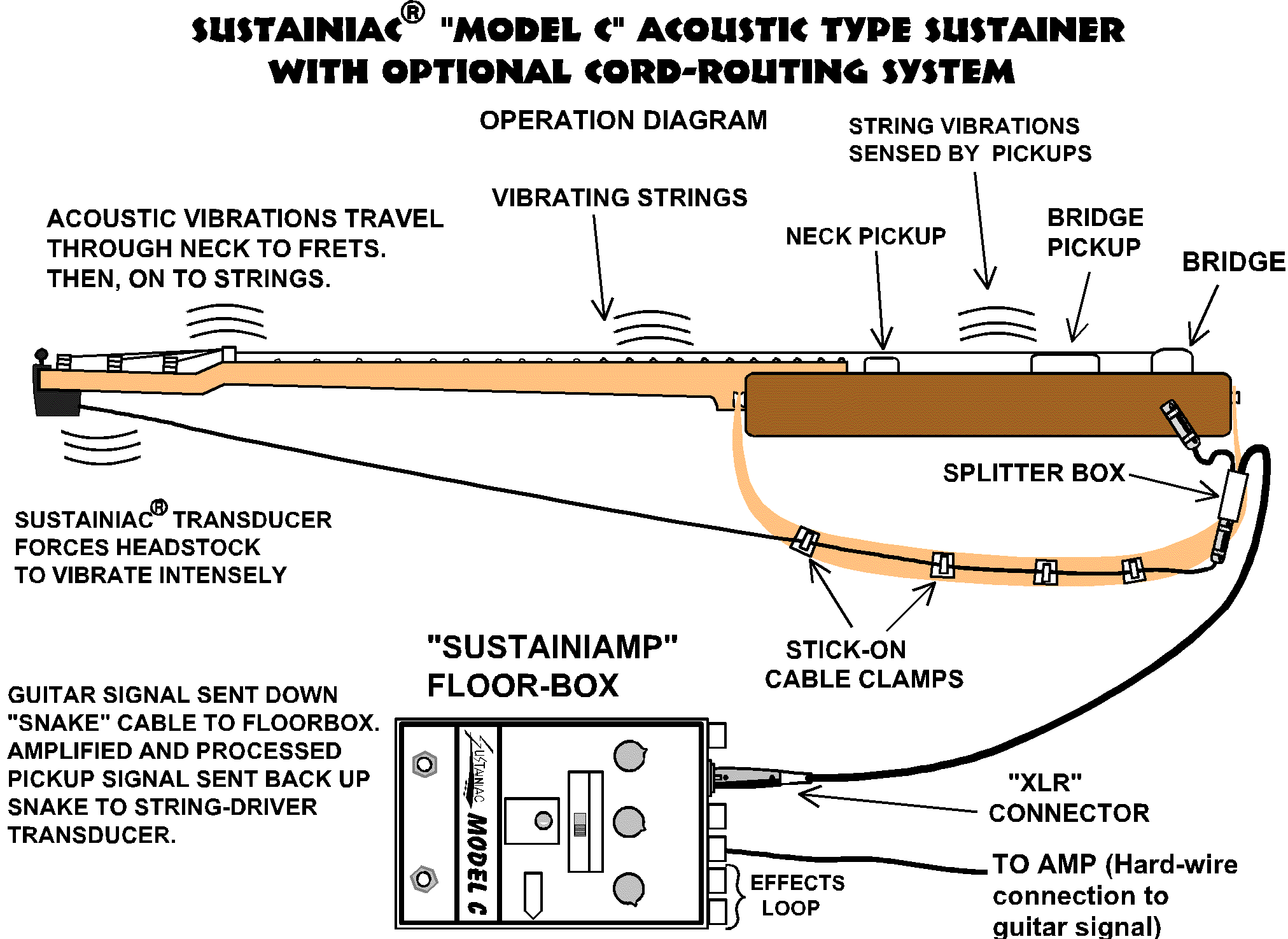
3937 Cranbrook Dr., Indianapolis IN 46240 Phone: 317-340-1161
email: info@sustainiac.com